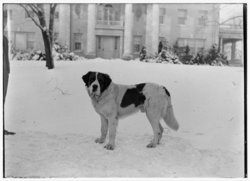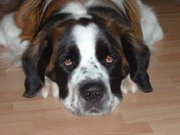St. Bernard (dog)
|
|
| St. Bernard | ||||||||||||
|---|---|---|---|---|---|---|---|---|---|---|---|---|
 St. Bernard owned by Wilbur Wright | ||||||||||||
| Alternative names | ||||||||||||
| ||||||||||||
| Country of origin | ||||||||||||
| Switzerland | ||||||||||||
| Classification | ||||||||||||
| ||||||||||||
| Breed standards (external links) | ||||||||||||
| FCI (http://www.dogdomain.com/FCI/fcistandards/fci-061.htm), AKC (http://www.akc.org/breeds/saint_bernard/index.cfm), ANKC (http://www.ankc.aust.com/stbernar.html), KC(UK) (http://www.the-kennel-club.org.uk/discoverdogs/working/w870.htm), NZKC (http://www.nzkc.org.nz/br676.html) |
The St. Bernard Dog is a large dog originally bred for water rescue and as a working dog. It is known for its loyalty and vigilance and is tolerant of children, animals, and strangers. Because of those traits, it has become a family dog.
| Contents |
History
The origin of the St. Bernard cannot be fully determined. Formerly, they were the herding dogs of Swiss farmers as well as hunting dogs and watchdogs. Their history has also been connected with the hospice at the St. Bernard pass. First reports of the dogs' presence at the pass date to the 17th century, and they still are loyal companions to the monks there.
The most famous St. Bernard to save people at the pass was Barry (sometimes spelled Berry), who reportedly saved somewhere between 40 and 100 lives. There is a monument to Barry in the Cimeti貥 des Chiens and his body was preserved in the Natural History Museum in Berne[1] (http://www.nmbe.ch/deutsch/531_5_1_9.html).
Miscellaneous
Naming
The name "St. Bernard" was not in widespread use until the middle of the 19th century. The dogs were called "Saint Dogs", "Alpenmastiff" or "Barry Dogs" before, and in parts of North America, they're still called "Saints".
Dog Pictures and Clipart
- Pictures of Dogs (http://classroomclipart.com/cgi-bin/kids/imageFolio.cgi?direct=Animals/Dogs)
- Dog Clipart (http://classroomclipart.com/cgi-bin/kids/imageFolio.cgi?direct=Clipart/Animals/Dog_Clipart)
Clipart and Animal Pictures
- Clipart (https://classroomclipart.com/image/category/clipart.htm)
- Animal Clipart (https://classroomclipart.com/image/category/animal-clipart.htm)
- Animal Animated Clipart (https://classroomclipart.com/clipart/Animations/Animals.htm)
- Pictures of Animals (https://classroomclipart.com/image/category/animal-photos.htm)
- Amphibian Clip Art, Pictures and Photogaphs (https://classroomclipart.com/image/category/amphibian-clipart.htm)
- Farm Animal Clip Art, Pictures and Photographs (https://classroomclipart.com/image/category/farm-animal-clipart.htm)
- Mammal Clip Art, Pictures and Photographs (https://classroomclipart.com/image/category/mammal-clipart.htm)
- Marine Animal Clip Art, Pictures and Photographs (https://classroomclipart.com/image/category/marine-life-clipart.htm)
- Reptile Clip Art, Pictures and Photographs (https://classroomclipart.com/image/category/reptile-clipart.htm)
- Spider Clip Art, Pictures and Photographs (https://classroomclipart.com/image/category/spider-clipart.htm)



